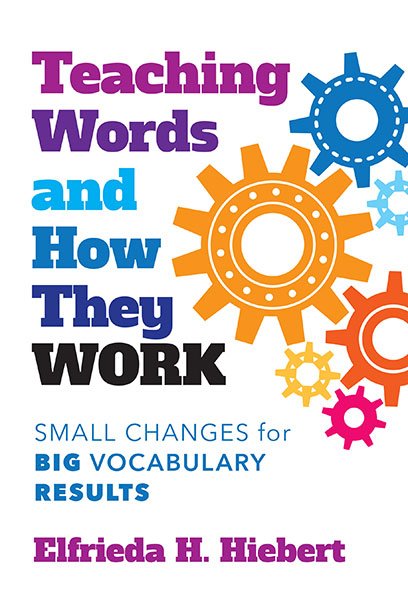Professors: Request an Exam Copy
Print copies available for US orders only. For orders outside the US, see our international distributors.
Publication Date: December 6, 2019
Pages: 168

“An accessible volume for any educator or curriculum director who desires to take an innovative approach to vocabulary instruction.” —Journal of Language and Literacy Education
“An empirically-based yet approachable guide for teachers to strengthen vocabulary instruction within their classrooms.” —Teachers College Record
Research shows that vocabulary is the best support for students’ comprehension of narrative and information texts. Often, vocabulary instruction focuses on a few target words in specific texts. However, to understand the many new words in complex texts students need to know how words work.
Written by an award-winning authority on reading instruction, this book shows teachers how to make small changes to teach more words and also how words work. Many of these small changes involve enrichments to existing vocabulary practices, such as word walls and conversations with students. Each chapter includes descriptions of teachers’ implementation of small changes to support big gains in students’ vocabulary. This book, which has sufficient depth in research and theory for graduate and undergraduate courses in vocabulary instruction, also offers practical steps that K–8 teachers can use in any reading program to help all students grow their vocabulary.
Teaching Words and How They Work shows teachers how to:
Elfrieda H. Hiebert is president and CEO of TextProject, Inc., recipient of Literacy Research Association’s Oscar S. Causey Award for outstanding contributions to reading research, and coauthor (with P. David Pearson) of Research-Based Practices for Teaching Common Core Literacy.
“An accessible volume for any educator or curriculum director who desires to take an innovative approach to vocabulary instruction.”
—Journal of Language and Literacy Education
“ Teaching Words can be a tool to inform early and late career educators seeking foundational knowledge about classroom vocabulary instruction. The historical footing paired with critical issues such as linguistic diversity, multilingual students, and intentional materials selection offers an empirically-based yet approachable guide for teachers to strengthen vocabulary instruction within their classrooms. As stated by Hiebert, ‘Long-lasting changes in the complex contexts of classrooms are made through steady application of small changes’ (p. x). With Teaching Words, educators can develop effective, meaningful vocabulary instruction one small change at a time.”
—Teachers College Record
“This book is a must-read for teachers who want to move their instruction beyond the weekly word list. By integrating small, specific changes, Hiebert helps you develop lasting improvements in your curriculum. She has created a viable process that can make a significant, long-term impact in the vocabulary development of your students without overwhelming you in the process. It should be on every educator’s bookshelf.” —Melanie Kuhn, Jean Adamson Stanley Faculty Chair in Literacy, Purdue University
“Teaching Words and How They Work stands to make a significant contribution to the field. Teachers are expected to juggle numerous priorities and supporting children's word learning is often the ball that gets dropped. This book provides teachers with small but powerful suggestions for including vocabulary instruction through already-established classroom practices so that teachers can address multiple objectives at once. By making the small changes Hiebert suggests, teachers can make a big difference in children's vocabulary and thereby support children's learning throughout their school years.”
—Rebecca D. Silverman, Stanford Graduate School of Education
Contents
Preface ix
1. Learning Words and How Words Work 1
Vocabulary and Texts: A Two-Way Relationship 2
Vocabulary Instruction: A Focus on Relationships Among Words, Not Individual Words 4
How to Implement New Vocabulary Insights: Small Changes = Big Results 8
The Last Word 10
2. Making Small Changes in Vocabulary Instruction 11
Small Changes = Big Results: WHY 12
Small Changes = Big Results: WHAT 13
Small Changes = Big Results: HOW 15
The Last Word 20
3. Why a Small Group of Word Families Is So Important 25
The Evidence 25
Small Changes = Big Results 35
The Last Word 38
4. A Short History of English and Why It Matters 41
The Evidence 42
Small Changes = Big Results 49
The Last Word 53
5. Recycling and Remixing: Multiple Meanings and Uses of Words 54
The Evidence 56
Small Changes = Big Results 61
The Last Word 64
6. The Vocabulary Networks of Narrative Texts 66
The Evidence 67
Small Changes = Big Results 77
The Last Word 80
7. The Vocabulary Networks of Informational Texts 82
The Evidence 83
Small Changes = Big Results 91
The Last Word 94
8. Vocabulary and Text Complexity Systems 98
The Evidence 99
Small Changes = Big Results 107
The Last Word 111
9. Different Labels But the Same Concepts: English Learners 113
The Evidence 114
Small Changes = Big Results 119
The Last Word 123
Children’s Literature and Instructional Texts 125
References 131
Index 139
About the Author 154
Professors: Request an Exam Copy
Print copies available for US orders only. For orders outside the US, see our international distributors.